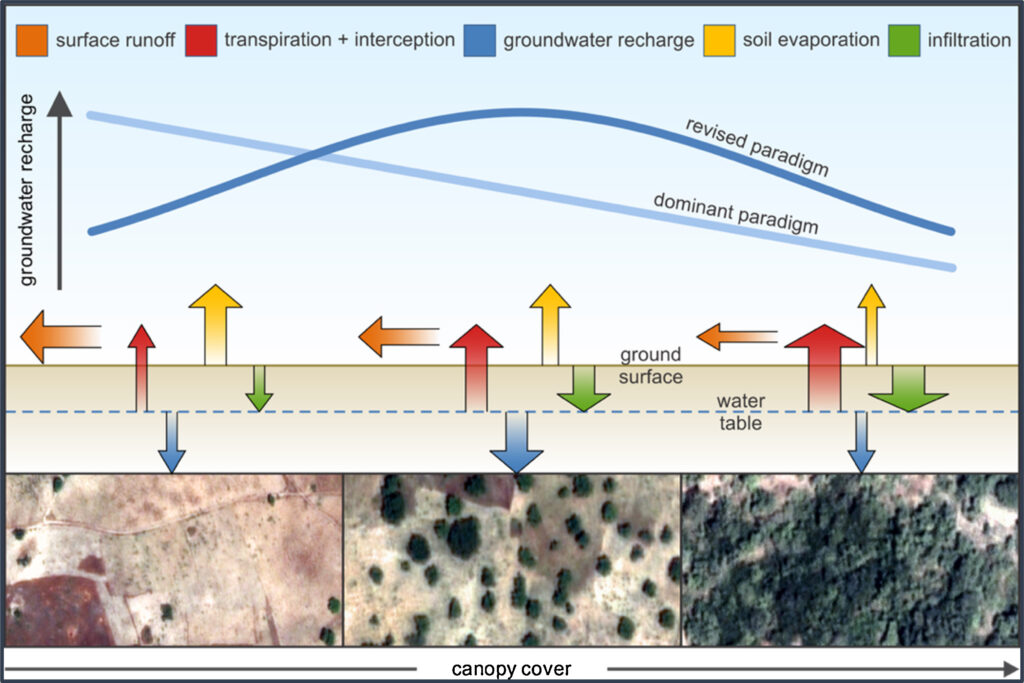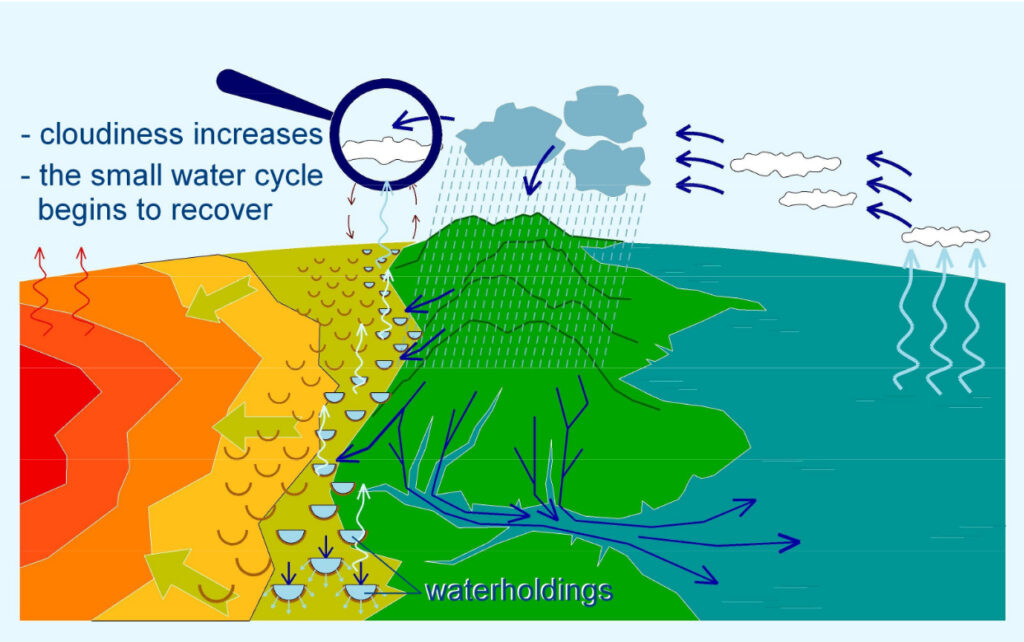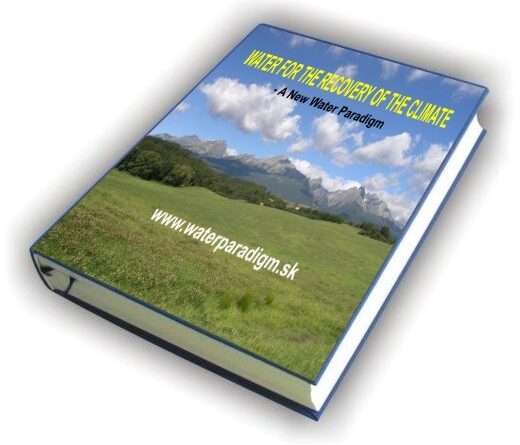Water for the Recovery of the Climate: A New Water Paradigm
A Resource Packet on the Work of Michal Kravčík and Colleagues
By Michael Pilarski, Global Earth Repair Foundation. January 2, 2023
I highly recommend this to the whole world! Michal Kravčík & colleagues’ solutions to global climate change. I rank their analysis and solutions for planetary regeneration right up there as the best in the world.
Feel free to forward this information, or elements of it, to where you think it might do some good.
Rehydrating the atmosphere by rehydrating degraded lands
The official climate narrative completely misses the solution that Michal Kravčík and others are bringing to the attention of the world, which is: rehydrating the atmosphere by rehydrating degraded lands with water retention structures(which will also serve the function of solving erosion issues). Increasing water retention in the landscape allows for increased vegetation. This results in more transpiration from plants which rehydrates the atmosphere of dry regions and increases rainfall there. Water begets more water. This increase in what Kravčík calls the “small water cycle” affects global weather and will be a stabilizing influence with less extreme storms. Forests transport water locally and globally. The whole planet benefits if we rehydrate the world’s degraded, lands.
“Small water cycle” & “Large water cycle”

The “small water cycle” is water in the atmosphere from evapotranspiration from land. The “large water cycle” is the atmospheric moisture/rainfall that blows onto the landmasses from the ocean. Rainfall that floods off a landscape quickly and back to the sea serves only once. Water held in the landscape, transpired by the vegetation falls again as rain farther into continents and then if caught and transpired again water can be recycled multiple times. It is estimated that water which falls on the on the ocean side of the Amazon can be re-transpired by the Amazonian forest 7 times before it reaches the Andes. This conveyer belt of evapotranspiration moisture can help green up drylands in continental interiors. This large increase in vegetative cover on the planet and rehydration of soils will result in enough carbon sequestration to bring atmospheric levels of carbon dioxide back to pre-industrial levels.
Water for the Recovery of the Climate: A New Water Paradigm
Michal Kravčík, Jan Pokorny, Juraj Kohutiar, Martin Kováč, Eugen Tóth. 2007.
The most in-depth look at their work: Read and download it. 94 pages.
Water for the Recovery of the Climate: A New Water Paradigm quote
“….worldwide implementation of the new water paradigm’s measures … promises a fundamental, across-the-board decrease in extreme weather events on land, a more uniform spreading of precipitation over the continents, effective protection from flood and drought, the stabilizing of the climate in rural and urban environments, enough water for the growth of the world population, as well as a decrease in economic damage caused by extreme weather events.”
Global Cooling from Plant Transpiration: Mechanisms and Uncertainties (Anastassia Makarieva webinar & recording)
I recently had the good fortune to attend a Webinar on January 2, 2023 by Anastassia Makarieva on Global Cooling from Plant Transpiration: Mechanisms and Uncertainties. Many of her colleagues participated including: Michal Kravčík, Jan Pokorny, Zuzka Mulkerin, Anna Kirilenko, Andrei Nefiodov, Ugo Bardi, David Ellison and others. Such a high level conversation! We could see the development of the world’s climate solutions evolve right before our eyes, and participate in it. I stand in awe at the knowledge in the room. Some of it goes right over my head, but I learned a lot. It is refreshing to be in a meeting not dominated by people from the USA. Most of the people on their team are from Central Europe and Russia. Anastassia Makarieva is Russian from St. Petersburg. The webinar was organized by the EcoRestoration Alliance. Anastassia did the main presentation. About 20 people contributed to the discussion. 87 people on the zoom call at one point.
Michel Kravčík on the Global Earth Repair Hall of Fame
Michal Kravcik: 1999 Goldman Prize winner, Slovakia
Here is a video of his acceptance speech.
Michal Kravčík, a hydrologist from Slovakia, succeeded in galvanizing community participation to stop a proposed large dam — an environmentally destructive project conceived during the Communist era of central planning. Using democratic principles, he presented effective alternatives that included the creation of small dams, decentralization of water management authority and restoration of agricultural lands. Kravčík helped reinvigorate the local economy by introducing sustainable development projects and has successfully encouraged increased voter participation in the country. The Goldman Environmental Prize is the world’s largest prize for grassroots environmentalists.
Our Global Earth Repair Summit had two sessions with representation from the team of people Kravčík works with.
Here is where you can watch the recordings:
Restoration of Natural Water Cycles and Climate – Act locally, think globally
Watershed Restoration, Rehydrating the Landscape.
Zuska Mulkerin, Michal Kravčík
No Trees, No Rain
Anastassia Makarieva, Jan Pokorny, Andrei Nefiodov, Hart Hagan
Research Paper: Trees, forests and water: Cool insights for a hot world
– On the Power of Forests to Water the Earth and Cool the Planet
David Ellison, Jan Pokorny, Martin Wild
Jan Pokorny is co-author of A New Water Paradigm with Michael Kravčík. This event was hosted by Biodiversity for a Livable Climate and GBH Forum Network. They kindly agreed to let the Global Earth Repair Summit air their program during our Summit.
An excellent look at the science. Tree, forest and vegetation cover (TFVC) affect climate locally and globally. We conclude that increasing TFVC could realistically promote both substantial global climate change mitigation, as well as comforting surface temperature change.

By David Ellison, et al.
Here is the closing summary from the book Water for the Recovery of the Climate: A New Water Paradigm:
“The circulation of water in nature takes place through the large and small water cycles. Humanity, through its activities and systematic transformation of natural land into cultured land, accelerates the run off of rainwater from land. Limiting evaporation and the infiltration of water into the soil decreases the supply of water to the small water cycle. The equilibrium of the water balance in the small water cycle is thus disturbed and it gradually starts to break down over land.
“If there is insufficient water in the soil, on its surface and in plants,immense flows of solar energy cannot be transformed into the latent heat of water evaporation but are instead changed into sensible heat. The surface of the ground soon overheats, and as a result, a breakdown in the supply of water from the large water cycle arises over the affected land.Local processes over huge areas inhabited and exploited by human beings are changed into global processes and with processes that occur without the assistance of human beings; together they create the phenomenon known as global climate change. The part of global climate change caused by human activities then is largely based on the drainage of water from the land, the consequent rise in temperature differences triggering off mechanisms which cause a rise in climatic extremes. The disruption of the small water cycle is accompanied by growing extremes in the weather, a gradual drop in groundwater reserves, more frequent flooding, longer periods of drought and an increase in the water shortage in the region.
“The part of climatic change which is the result of human activities(draining of a region), can be reversed through systematic human activity (the watering of a region). The watering of land can be achieved through saturation of the small water cycle over land by ensuring comprehensive conservation of rainwater and enabling its infiltration and evaporation. This can help achieve the renewal of the small water cycle over a region and fundamentally change the trend of changing climatic conditions: it can—to reverse the trend of regional warming—temper extreme weather events and ensure a growth in water reserves in the territory.

“The renewal of the small water cycle over an area, however, depends not only on the extent to which the area has been damaged but also on a number of other factors. In the case of Slovakia, we can expect visible results relatively soon (10 to 20 years) after implementation of these measures. The financial costs of these specific measures are moderate sums which can be allocated from state, public and private budgets. Support for the implementation of far-reaching measures should be linked pro-rata to each 1 m3 of reservoir volume built in the ground or to anti-erosion measures carried out. The implementation of water conservation measures should, until the renewal of the small water cycle and the maximalization of a stable water balance in a region, replace previous investment measures, which only served to accelerate the runoff of water from a region.
“The conservation of rainwater on land “in situ” and the conducting away only of the natural surplus of water in a region is “condicio sine quanon”—a condition essential for ensuring environmental security, global stability and the sustenance of economic growth. Fulfilling these conditions should be of interest to each individual and each community. This is the first time in the history of human civilization when the impact of mankind’s activities on the water cycle and the decrease of amount of water in it will have to be evaluated. The statement of the Srí Lankan king, Parakramabahu the Great—”Not even a single raindrop should be allowed to flow into the sea without it first having been used for the benefit of the people…” —is the best summing up of the new water paradigm, a statement which, in the coming decades, should become a slogan for mankind calling for the preservation of civilization.”




